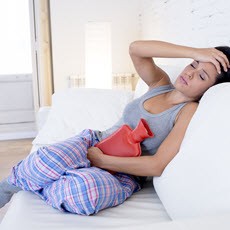Period cramps, that familiar throbbing pain in your lower abdomen, are a common experience for many women during menstruation. But why do they happen? This article explores the science behind menstrual cramps, examining their causes, symptoms, and potential remedies.
Understanding the Cause of Period Cramps
Menstrual cramps, medically known as dysmenorrhea, occur due to the contraction of the uterine muscles. These contractions help shed the uterine lining during your period. A key player in this process is a hormone-like substance called prostaglandins. Higher levels of prostaglandins are associated with more intense uterine contractions and, consequently, more severe cramps.
Primary Dysmenorrhea
This is the most common type of period pain, not caused by any underlying medical condition. It typically starts a day or two before your period and lasts for a few days. The intensity often lessens with age or after childbirth. The primary culprit? You guessed it—prostaglandins.
Secondary Dysmenorrhea
This type of cramp often starts later in life and is caused by conditions affecting the uterus or other reproductive organs, such as endometriosis or uterine fibroids. Pain from secondary dysmenorrhea can worsen over time and might begin before your period starts, continuing even after it ends. Diagnosis and treatment require addressing the underlying condition.
Recognizing the Symptoms
While cramping is the hallmark symptom, period pain can manifest in other ways:
- Lower back pain: Pain radiating to the lower back is common.
- Nausea and Vomiting: Some women experience digestive upset.
- Diarrhea: Changes in bowel habits can also occur.
- Headaches: Hormonal fluctuations can trigger headaches.
 Woman experiencing period cramps.
Woman experiencing period cramps.
Finding Relief from Period Cramps
Fortunately, there are ways to manage and alleviate period pain. Here are some strategies:
Home Remedies
- Heat Application: Applying a heating pad or taking a warm bath can relax muscles and ease cramping.
- Exercise: Light exercise can improve blood flow and reduce pain.
- Relaxation Techniques: Yoga, meditation, and deep breathing can help manage stress and pain.
Over-the-Counter Pain Relief
- NSAIDs: Nonsteroidal anti-inflammatory drugs (NSAIDs) like ibuprofen or naproxen can reduce prostaglandin production, lessening cramps. Consult a healthcare provider before using NSAIDs, especially if you have underlying health conditions.
When to Seek Medical Attention
While some discomfort is normal, consult a healthcare professional if:
- Pain is severe and interferes with daily life: Debilitating pain shouldn’t be ignored.
- Cramps suddenly worsen: A sudden increase in pain could indicate a problem.
- Severe cramps begin after age 25: This could signal secondary dysmenorrhea.
- Fever accompanies cramps: Fever suggests infection.
- Pain persists outside of menstruation: Pain unrelated to your cycle warrants investigation.
Diagnosis and Treatment of Severe Cramps
Diagnosing severe period pain involves a medical history review, pelvic exam, and potentially imaging tests like ultrasound. Laparoscopy might be necessary to diagnose conditions like endometriosis. Treatment for primary dysmenorrhea often includes hormonal birth control or prescription pain relievers. Secondary dysmenorrhea treatment addresses the underlying condition, sometimes requiring surgery.
Conclusion
Understanding the causes and symptoms of period cramps empowers you to seek appropriate relief. While home remedies and over-the-counter medications often help, persistent or severe pain requires medical attention. Consulting a healthcare professional ensures accurate diagnosis and effective management of your period pain, leading to improved well-being during menstruation.